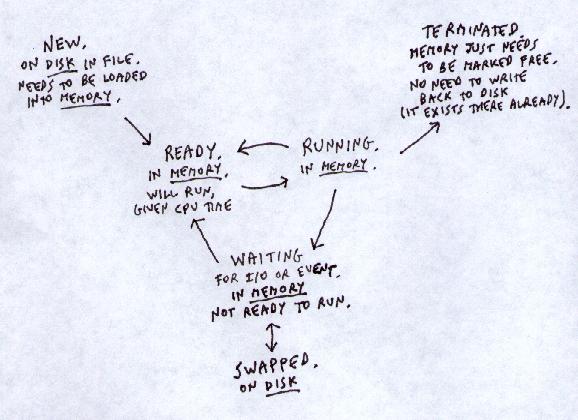Some scenarios:
ps -u $USER -f | grep bash
ps -Af | grep nano


In the "Details" tab of Task Manager you can look at a range of features of each process.
Right click the top bar and "Select columns" to select the columns to show.
You can sort on any column.
Here sorted on Page faults.
Starts running.
May pause when doing disk I/O, waiting on user event, etc.
Does not always have work for CPU to do.
May pause for long time.

READY to RUNNING -
Short-term (CPU) scheduler
decides if you can run now.
RUNNING to WAITING - I/O or event wait.
WAITING to READY - I/O or event completion.
Short period of calculation (short "CPU burst") Long period of I/O Short period of calculation Long period of I/O ..i.e. Most processes regularly "vote themselves" off the Running list anyway. - We don't have to force them to go.
Threads
2 (or more) flows of control in the same process.
2 (or more) instruction counters.
Same memory (same data and code space).
e.g. Web server - Each request is a separate thread,
all running in parallel until request completed.
e.g.
Web browser - multiple windows downloading at same time.
Each is a separate thread in same process.
see all processes and threads: ps -ALf LWP = thread id note multiple threads within same process id PID NLWP = no. of threads in this process sort by processes with the most threads: ps -ALf | sort -k6 -n show threads for one process: ps -Lf -p (PID)
Modern OS will schedule threads and processes across multiple cores.
Processor affinity - The idea that once a process or thread starts running on one core, it is often more efficient to leave it there (and its data in the core's cache memory) rather than change cores.
Display number of cores available: ===================================== $ nproc 4 Show info about the multiple cores: ===================================== $ cat /proc/cpuinfo Run process using core n (where n is 0 to 3 here): =================================================== $ taskset -c n prog See what processes are currently using what cores: ==================================================== $ ps -Ao user,pid,ppid,comm,psr USER PID PPID COMMAND PSR root 1 0 init 0 root 2 0 kthreadd 2 root 3 2 ksoftirqd/0 0 root 25 2 watchdog/3 3 root 328 1 udevd 3 humphrys 29858 29855 sshd 0 humphrys 29859 29858 csh 0 humphrys 32373 29859 ps 1 humphrys 32374 29859 grep 1 # PSR will be 0 to 3 here Query if process is bound to a core: ======================================= $ taskset -p 3 pid 3's current affinity mask: 1 $ taskset -p 25 pid 25's current affinity mask: 8 # 0001 (1) - bound to core 0 (see process 3 command /0) # 0010 (2) - bound to core 1 # 0100 (4) - bound to core 2 # 1000 (8) - bound to core 3 (see process 25 command /3) $ taskset -p 1 pid 1's current affinity mask: f # 1111 (f) - can run on all 4 cores, not tied to any core See load on different cores: ============================== $ top (and then press 1)
/var/log
tail -20 fail2ban.log
/var/log/lastlog
lastlog -t 2 lastlog -t 2 | sort -k4